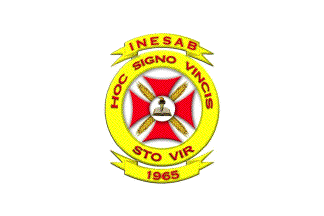 image by Ivan Sache, 16 August 2014
image by Ivan Sache, 16 August 2014
Last modified: 2024-03-02 by rob raeside
Keywords: education |
Links: FOTW homepage |
search |
disclaimer and copyright |
write us |
mirrors
See also:
 image by Ivan Sache, 16 August 2014
image by Ivan Sache, 16 August 2014
Institucion Educativa San Bartolomé (INESAB) was established on 28 October
1965 in Córdoba (Nariño Department) by the parish priest Remigio Nicolás Narváez
Benavides. Classes started on 25 December 1965.
The flag of the institute is white with the institute's emblem in the middle.
White is a symbol of purity and rectitude.
The emblem of the institute is made of three concentric circles. The central
circle features a torch pointing to the north. As a guide and source of light,
the torch is a symbol of truth, liberty and personal education guided by
perseverance, audacity and adventure. The torch is supported by the Bible, a
symbol of the search for truth. The middle circle is charged with a cross
symbolizing struggle, force, and spiritual triumph. Light emerges from the cross
of Christ, as the eternal light of transcendence, resurrection, and
redemption. The external circle is charged with the writing "HOC SIGNO VINCIS"
(should be "IN HOC SIGNO VINCES" / In This Sign You Will Conquer) and "STO VIR"
(Should be "ESTO VIR" / "Be a Man"), which form the essence of the institute's
philosophy. Red is a symbol of love, courage, and spiritual highness. Yellow is a
symbol of light and knowledge.
Source:
http://iesanbartolome2012.blogspot.fr/2012/11/quienes-somos.html -
Institute's website
Ivan Sache, 16 August 2014
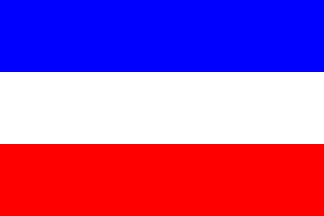 image by Ivan Sache, 07 July 2011
image by Ivan Sache, 07 July 2011
"Institución Educativa Colegio San Bartolomé" is located in San José de
Cúcuta (Cúcuta Department).
The flag of the institute, as shown on the institute's blog, is horizontally
divided blue-white-red.
Source:
http://colsanbartolome.blogspot.com/2009/08/escudo-del-colegio.html
Ivan Sache, 07 July 2011
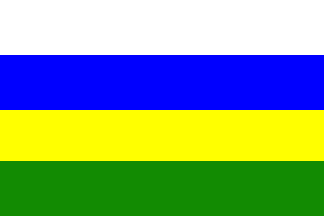 image by Ivan Sache, 3 January 2021
image by Ivan Sache, 3 January 2021
Colegio San Benito was established in borough San Benito, La Candelaria,
Medellín, by Resolution No. 14,311 issued on 24 December 2014.
The flag
of Colegio San Benito is horizontally divided white-blue-yellow-green.
White
is an achromatic color, of maximum brightness and null darkness. It symbolizes
light, kindness, innocence, purity and peace. White is considered as the color
of perfection, also meaning security, purity, faith and limpidity.
Blue is a
symbol of deepness, coldness, stability, seriousness, confidence, faith and
eternity. It is called the color of all colors, especially for tranquility and
calm it conveys. In contrast with yellow, blue supplies freshness.
Yellow is
connected with two transcendent elements, the sun, source of life, and gold. It
is considered as the symbol of wealth. It symbolizes intelligence, energy and
felicity. Associated with the sun, yellow conveys a sense of energy and glee.
The emotional effects of yellow are optimist and bright. Combined with green,
yellow suggests natural freshness; combined with blue, it creates a sense of
limpidity while combination with white slightly attenuates its brightness.
Green, evokes the natural environment and symbolizes harmony, growth, fertility
and freshness. Emotionally, green symbolizes security. In heraldry, it
represents belief and hope. Olive green is connected with peace, via the olive
branch.
http://sanbenito.edu.co
School website
Ivan Sache, 3 January 2021
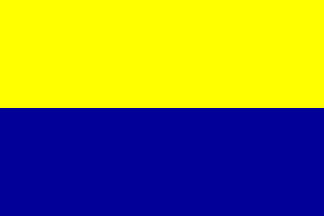 image by Ivan Sache, 26 July 2014
image by Ivan Sache, 26 July 2014
Colegio San Benito de Tibatí was established in Bogotá by the Order of Saint
Benedict (Benedictines). On 6 August 1960, Luis Concha Córdoba, Archbishop of
Bogotá, welcomed four monks - Lawrence Wagner, Frederic Mundt, Anselm Ruelle and
Adrian Mundt - from the abbey of the Assumption, Richardton, North Dakota (US).
They were invited by the archbishop to contribute to the improvement of Catholic
education in Bogotá. The four monks established Colegio San Carlos, where
classes started in February 1961. On 15 September 1963, the foundation of the
priorate of Tibatí was approved. The priorate was named for a Chibcha word
meaning "Joy of the Lord". In February 1969, the priorate was allowed to teach
novices. Under the guidance of Father Valeriano Oldermann, the monks of Tibatí
purchased the plots surrounding Colegio San Carlos and established Colegio San
Benito de Tibatí. Classes started on 12 February 1979.
The flag of the institute is horizontally divided yellow-dark blue. Yellow is a
symbol of valour and spiritual force, of equity and felicity, and of joy
and common life in harmony. Blue is a symbol of academic skills, magnanimity,
and truth.
Source:
http://www.csbt.edu.co/Simbolos_Institucionales_CSBT.php - Institute's
website
Ivan Sache, 26 July 2014
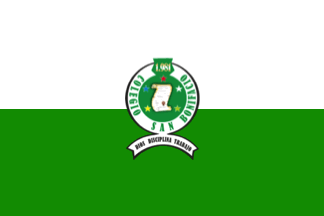 image by Ivan Sache, 3 January 2021
image by Ivan Sache, 3 January 2021
Colegio San Bonifacio was established on 10 March 1981 in Bogotá by Ligia
Celmira Abril and Luis Alfredo Torres.
The flag of Colegio San Bonifacio
is horizontally divided white-green with the school's emblem in the center.
Photos
https://colegiosanbonifacio.edu.co/uncategorized/posesion-personero-2020
Ivan Sache,
3 January 2021
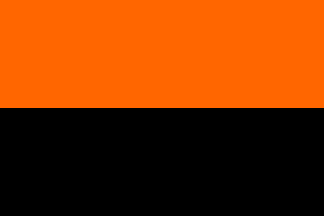 image by Ivan Sache, 6 February 2010
image by Ivan Sache, 6 February 2010
Flag of Universidad de San Buenaventura is based on <www.usb.edu.co>.
Dov Gutterman, 3 June 2001
The flag is horizontally divided orange-black. The website
says that orange stands for youth, creativeness and intelligence,
and black for sobriety, rigour and academic excellence.
Ivan Sache, 3 June 2001
Colegio de San Buenaventura was founded at the end of the 17th
century in Santa Fé de Bogotá by the Franciscan Order; on 5
November 1861, Tomás Cipriano de Mosquera ordered the
suppression of all the religious communities from the national
territory and closed the old college. Universidad de San
Buenaventura (USB) was refounded on 14 June 1961 in Bogotá (main
seat), sections being subsequently founded in Medellín (1966),
Cali (1970) and Cartagena (1994).
Source: USB
website.
Photos of the flag: Bogotá
- USB main seat, Medellín
section, Cartagena
section (Album "Auditorio", picture #10 and last).
The university's website shows a drawing
of the flag charged with the university's seal in the middle,
which is not supported either by the description of the flag or
photographical evidence.
Ivan Sache, 6 February 2010
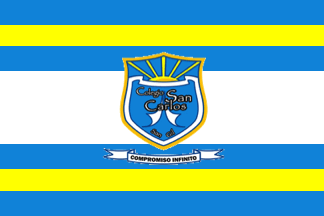 image by Ivan Sache, 12 December 2020
image by Ivan Sache, 12 December 2020
Colegio San Carlos was established in San Gil (Santander) by Municipal
Agreement No. 25 issued on 27 August 2002, succeeding Colegio Seminario San
Carlos, which had been established in 1972 following a convention signed by the
Colombian Government and the Colombian Episcopal Conference. The old Seminario
Menor Conciliar San Carlos Borromeo of the Diocese of Socorro and San Gil had
been established by Resolution No. 5,977 issued on 11 December 1958.
http://colsancarlossangil.edu.co/
School website
The flag of Colegio San Carlos is horizontally divided
blue-yellow-blue-white-blue-yellow-blue (1:1:1:3:1:1:1), with the scroll's
emblem in the center.
http://colsancarlossangil.edu.co/index.php/page/item/31
School website
The Spanish motto reads "Compromiso Infinito", "Infinite Compromise".
Ivan Sache, 12 December 2020
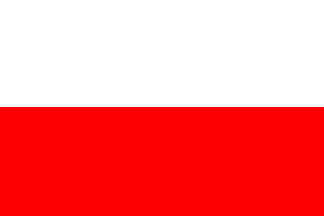 image by Ivan Sache, 1 January 2021
image by Ivan Sache, 1 January 2021
Gimnasio Moderno San Carlos is located in Mosquera (Cundinamarca).
The
flag of Gimnasio Moderno San Carlos is horizontally divided white-red.
White
represent the children's purity, tolerance and virtues.
Cherry red represents
the institute's love, force and commitment to quality to reach excellence.
https://www.gimnasiomodernosancarlos.edu.co/representacion
School
website
Ivan Sache, 1 January 2021
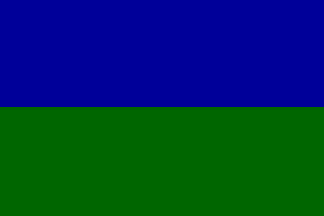 image by Ivan Sache, 04 August 2014
image by Ivan Sache, 04 August 2014
Liceo San Carlos is located in Cajica (Cundinamarca Department).
The flag of the institute is horizontally divided blue-green.
Source:
http://liceosancarlos.edu.co/emblemas.html - Institute's website
Ivan Sache, 04 August 2014
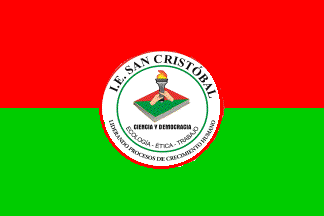 image by Ivan Sache, 06 August 2014
image by Ivan Sache, 06 August 2014
Institución Educativa San Cristóbal was established in April 1966 in Medellín
(Antioquia Department).
The flag of the institute is horizontally divided red-green with the institute's
emblem in the middle. Red is a symbol of love, optimism, cooperation, and
harmony. Green is a symbol of faith, projection, hope, admiration, and love for
the natural environment.
The emblem of the institute shows on a white background a book symbolizing
science and aspiration to learn. The cover of the book is diagonally divided
into two parts coloured like the flag. The book supports a torch hold by two
hands, meaning union, integration, fraternity, and aspiration to surpassing.
Beneath the books is the writing "CIENCIA Y DEMOCRACIA" (Science and Democracy)
in bold black letters, surmounting the writing "ECOLOGÍA - ÉTICA - TRABAJO"
(Ecology - Ethics - Work) forming an arch. The whole is inscribed in a green
ring. The outer border of the emblem, limited by a red ring, is inscribed on top
with the institute's name, "I.E. SAN CRISTÓBAL" and on bottom with "LIDERANDO
PROCESOS DE CRECIMENTO HUMANO" (Leading the Processes of Human Growth).
Source:
http://www.iesancristobal.edu.co/index2.php?id=4151&idmenutipo=734&tag= -
Institute's website
Ivan Sache, 06 August 2014
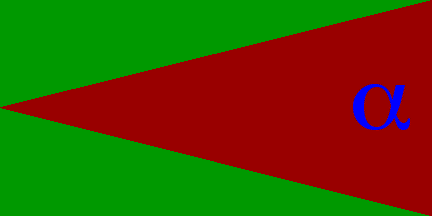 image by Ivan Sache, 16 December 2008
image by Ivan Sache, 16 December 2008
"Colegio Campestre San Diego" was founded in Chia on
12 February 1994, succeeding the "Liceo San Diego" of
Bogotá.
The flag of the institute, as shown graphically and described on
the institute's
website, is dark red with two right-angle triangles placed
along the hoist and a blue Greek letter "alpha" near
the hoist. The triangles form a wide perspective on which is
projected the "alpha" symbol.
The colours suggest that the power of love (red wine red) and the
depth of life, shown in the sky and the sea (blue), converge at
the infinite and feed the permanent retroalimentation of hope and
empathy with the natural environment (green).
Ivan Sache, 16 December 2008
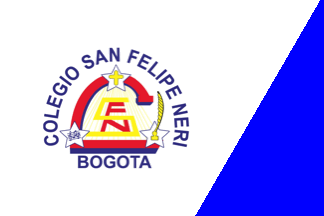 image by Ivan Sache, 30 September 2018
image by Ivan Sache, 30 September 2018
Colegio San Felipe Neri was established in 1965 in borough Alcazares (Bogotá)
by the Congregation of the Oratory of Saint Philip Neri and approved by
Ministerial Resolution No. 13,510, adopted on 28 July 1982. St. Philip Neri
(1515-1595; canonized in 1622 by Pope Gregory XV) had the Oratory recognized by
the Holy See in 1575.
The flag of Colegio San Felipe Neri is white with a
blue triangle placed along the fly and the school's emblem in the center. Blue
represents the celestial highness and the devotion of St. Philip Neri to the
Blessed Virgin. White represents the Roman Catholic Church and purity.
The emblem of the school represents the three virtues exercised in the
institute: Study (ink pot and quill), Prayer (cross), and Joy (sheet music).
Study: Education to life, liberty, critical thought, creativity and Christian
life.
Prayer: Connection with God, translated into respect for the family,
solidarity, responsibility and political awareness.
Joy: Vivid satisfaction,
pleasure, happiness.
http://www.sanfelipeneribogota.edu.co/micolegio.php?sec=2
School website
Ivan Sache,
30 September 2018
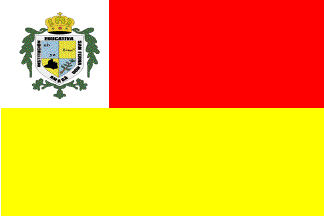 image by Ivan Sache, 6 March 2017
image by Ivan Sache, 6 March 2017
Institución Educativa San Fernando is based in Amagá, Antioquia Department.
The symbols of the institute are described in the Preamble of the institute's
Constitution, as follows:
The symbols of the institute were registered on 9
September 1966, as No. 16, by the Chronicler of Arms Hernán Escobar Escobar
[indeed a local historian and heraldist, designer of the coat of arms of Itagüí
and La Estrella]
The flag is described as follows:
1. Shape and
dimensions
The colours are based on those used in the official coat of arms
A. Colours
1. White
2. Red
3. Golden yellow.
B. Distribution: Two
horizontal stripes fully equal in height :
1. Upper stripe: Divided, the
first third, white, charged with the coat of arms, and the other two-thirds, red
2. Lower stripe: Golden yellow
2. Symbolic of the colours of the
institute
1. White: Purity, integrity, obedience, firmness, vigilance,
eloquence.
2. Red: Valour (audacity, intrepidity), strength, triumph,
highness.
3. Yellow: Nobleness, magnanimity, wealth, power, light, constancy,
wisdom, force, faith.
The coat of arms is explained as follows:
1.
Bordure: A symbol of valour
2. Division: [The written description does not
make sense, referring to three quarters while the shield is divided in four
quarters]
3. Chief: [The written description does not make sense, either;
referring to "the chief, covering the upper third of the shield"]
4. Letters
ab-yz [in the first quarter, on a blue background, "ab" in chief dexter and "yz"
in base sinister] : The source of knowledge,
also a tribute to the Spanish
language used at the institute
5. Formula of relativity E=mc^2 [in the second
quarter, on a yellow background, centered]: Expression of modern science,
representing the excellence of education at the institute.
6. Coal [in the
third quarter, black on a yellow background]: Representing the mineral resources
of the region where the institute is established, also a symbol of fire, heath,
spiritual and cultural light transmitted from generation to generation.
7. A
branch of coffee [in the fourth quarter, proper on a blue background): the base
of the national wealth, abundant in the region.
8. Royal crown [above the
shield]: A tribute to King St. Ferdinand of Bourbon [rather King of Castile
Ferdinand III the Saint], patron saint of the municipality and the institute's
namesake.
http://master2000.net/recursos/menu/488/3787/mper_arch_33161_MANUAL%20CONVIVENCIA%202016-2019.pdf
- Institute's Constitution
Ivan Sache, 6 March 2017
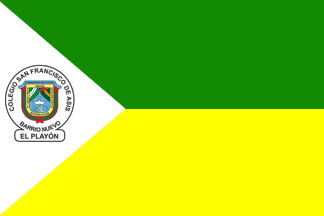 image by Ivan Sache, 12 December 2020
image by Ivan Sache, 12 December 2020
Colegio San Francisco de Asís was established in Barrio Nuevo, El Playón
(Santander) on 17 February 1998 by Mayor Ramiro Alarcón Caicedo as a secondary
seat of Colegio Camilo Torres. The school became independent on 16 March 2003,
encompassing a central seat and 12 rural seats.
http://colfrasis.edu.co/
School
website
The flag of Colegio San Francisco de Asís, designed in 2004 by
Antonio María Villamizar Contreras, is horizontally divided green-yellow, with a
white triangle placed along the hoist and charged with the school's coat of
arms.
Green is a symbol of natural resources projected in ideals of
democracy and liberty.
Yellow is a symbol of the resources of knowledge,
science, values, culture, uses and customs that integrally educate students.
The white triangle is a symbol of peace, purity, honesty, knowledge, solidarity,
innocence and nobleness, which are part of the children's essence, expressed in
their acts, student's life, and in society.
The coat of arms of Colegio
San Francisco de Asís, designed in 2004 by Elquín Fernando Esteban Acosta and
Carlos Julián Díaz Jaimes, features in the center a water drop, recalling the
water resources of the municipality, which is among the main water producers at
the departmental and national scales.
The lateral parts feature the flags of
Santander and El Playón, highlighting love for the motherland.
The dove and
the laurel branch emphasize the great diversity of fauna and flora, which need
to be protected.
In the lower part are featured a biretta and the Olympic
rings, the first emphasizing student's triumph in their achievements, the latter
representing their commitment to sport and health.
In the upper part appears
a scroll inscribed "FORMADORES DEL FUTURO" [Educators of the Future], the
school's motto, completed by the words "VIRTUD" Virtue], "SABIDURIA"
[Knowledge], "ESPERANZA" [Hope], and "INTEGRACION" [Integration].
http://colfrasis.edu.co/
School
website
Ivan Sache, 12 December 2020
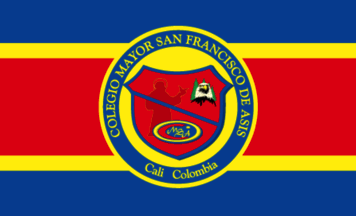 image by Ivan Sache, 22 August 2017
image by Ivan Sache, 22 August 2017
Colegio Mayor San Francisco de Asís (CMSA) was established in 2000 in borough
Ciudad Jardín, Cali (Valle del Cauca). Founded by Sandra Patricia Sadovnik as
Colegio Infantil San Francisco de Asís, the institute was renamed as Colegio
Mayor San Francisco de Asís in 2006.
http://cmsa.edu.co - CMSA website
The flag of CMSA is horizontally
divided blue-red-blue, the blue stripes being thinner and separated from the rd
stripe by thin yellow stripes. The institute's coat of arms is placed in the
center of the flag.
The colors are those of the national flag. The coat
of arms features the silhouette of St. Francis of Assisi, representing the
spiritual, human and Christian education provided to the students. The bald
eagle represents the vision, valor and power that guide the institute in its
search for excellence.
http://cmsa.edu.co/horizonte - CSMA website
Ivan Sache, 22 August
2017
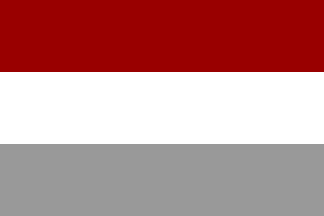 image by Ivan Sache, 19 January 2016
image by Ivan Sache, 19 January 2016
Institución Educativa San Francisco de Asís (IESFA) was established in
Puerto Asis by Agreement No. 13 of 27 April 1995, as Instituto Técnico
Industrial San Francisco de Asís.
The institute is named for St. Francis of Assisi (1181/82-1226,
canonized on 16 July 1228 by Pope Gregory IX).
The flag of IESFA is horizontally divided purple red-white-gray.
The upper stripe is a symbol of fire in every student's heart.
The white stripe is a symbol of purity and innocence. The gray stripe is a symbol of technical and industrial skills taught
at IESFA.
Source:
Institute's website
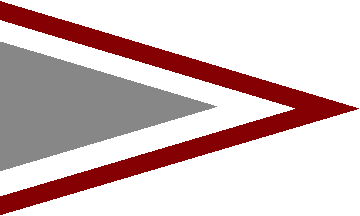 image by Ivan Sache, 01 September 2017
image by Ivan Sache, 01 September 2017
The music band of IEFSA uses a triangular pennant at the institute's
colours, arranged in a triangular pattern. (Photo)
Ivan Sache, 19 January 2016
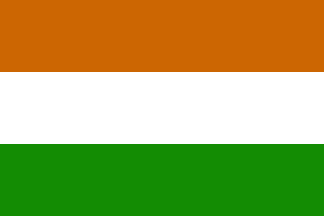 image by Ivan Sache, 2 December 2018
image by Ivan Sache, 2 December 2018
Institución Educativa San Francisco de Asis is located in Tuquerres (Nariño
Department).
The flag of IE San Francisco de Asis is horizontally divided
brown-white-green.
https://sites.google.com/site/iesfatq/himno
Ivan Sache, 2 December 2018
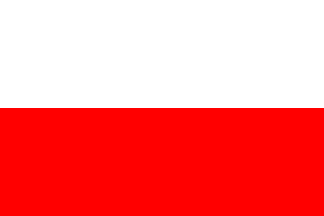 image by Ivan Sache, 9 November 2010
image by Ivan Sache, 9 November 2010
The St. Francis of Assisi Royal College was founded in 1662, as part of the
Popayán Seminary, founded by the Jesuit father Francisco Fuentes, the Dean
Francisco Vélez de Zúñiga and the Bishop of Popayán Francisco de la Serna y
Rimaga Salazar, and officially approved on 4 October 1643 by King of Spain
Philip IV. After the expelling of the Jesuits by Charles III in 1767, the
institute was managed for a few years by the Dominicans, the Jesuits being
reinstated in 1783 and expelled again in 1850 by General Tomás Cipriano de
Mosquera's government. In 1869, the Bishop Carlos Bermúdez decided to reorganize
the Seminary and obtained from Pope Pius IX its allocation to the Lazarists. On
2 February 1881, Fathers Gustavo Foing and Juan Bautista Rieux arrived in
Popayán; the Lazarists would manage the Seminary until 1942, when the Seminary
and the College were separated. The college was renamed Colegio de Nuestra
Señora del Pilar, eventually closed in 1953. In April 1963, the St. Francis of
Assisi Royal College was restored by the Association of the Ex-Alumni of the
college, that granted its management to the (Lazarist) Congregation of the
Mission.
The flag of Real Colegio San Francisco de Asís, as shown on the institute's
website, is horizontally divided white-red. White represents purity, dignity,
justice, zeal, truth, perseverance, gratitude, kindness, good faith, joy and
peace. Found in the highest points of the natural environment, on top of the
mountains and in the clouds, it symbolizes high aspirations and noble ideas. Red
is the color of sacrifice, blood and life, heroism, patriotism and courage.
The flag should be used in all ceremonies held in the institute, together with
the national, departmental (Cauca) and municipal (Popayán) flags, and placed on
the honor place, left.
Source:
http://www.sanfranciscodeasispopayan.edu.co/op2/bandera.htm
Ivan Sache, 9 November 2010
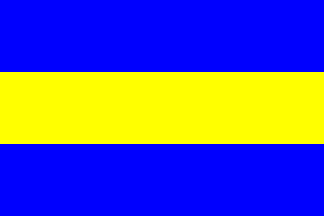 image by Ivan Sache, 30 June 2014
image by Ivan Sache, 30 June 2014
Colegio San Francisco was established on 5 October 1935 in Tuluá (Valle
Department) by the Franciscan Fathers, as Escuela San Francisco de Asís. Centro
Comercial de Educación Media San Antonio de Padua was established on the same
site on 22 September 1935.
The flag of the institute is horizontally divided blue-yellow-blue. Blue is a
symbol of heavens. Yellow is a symbol of spirituality.
Source:
http://www.colegiosanfranciscotulua.edu.co/simbolos.html
Ivan Sache, 30 June 2014
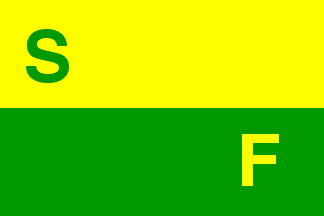 image by Ivan Sache, 27 September 2014
image by Ivan Sache, 27 September 2014
Institución Educativa Indígena San Francisco "El Paki" was established in
1962 by Medardo Canole Chima, a political leader of the time, in the village of
San Francisco. Destroyed by a blaze in 1990, the school was rebuilt in the
indigenous community of El Paki, part of the municipality of Sampués (Sucre
Department).
The flag of the institute is horizontally divided yellow-green, with a green
letter "S" in the upper hoist and a yellow letter "F" in the lower fly.The
yellow stripe is a symbol of the resources of the community. The green stripe is
a symbol of the fertility of the soil.
Source:
http://www.ineisa.edu.co/seccion.asp?idseccion=2&idsubseccion=7 -
Institute's website
Ivan Sache, 27 September 2014
"Institución Educativo Distrital San Francisco I La
Casona" was founded 36 years ago in Bogotá.
The flag of the institute, according to a photo available on the website
of the institute, is horizontally divided blue-yellow-green
(1:2:1) with the emblem of the institute in the middle.
The emblem of the institute was designed by Ferney Peña in 2005.
Ivan Sache, 27 January 2009
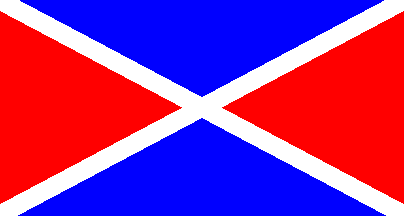 image by Ivan Sache, 22 September 2014
image by Ivan Sache, 22 September 2014
Institución Educativa Departamental San Francisco is located in the village
of San Francisco, part of the municipality of Junín (Cundinamarca Department).
San Francisco had its first school established in 1910, in a informal manner.
Escuela El Pino was built in 1922; another school for boys was built in 1933.
Escuela de Buenos Aires and Escuela de Santa Rosa were established in 1960 and
1966, respectively. Colegio Basico de San Francisco was established by
Resolution No. 742 of 19 August 1999. Institución Educativa Departamental San
Francisco was eventually established by Resolution No. 4,451 of 19 October 2005.
The flag of the institute is divided red-blue by a thin white saltire. Red
represents our own blood and our working and valiant people. Blue represents
heavens and hope.
Source:
http://www.actiweb.es/inedesanfra/ - Institute's website
Ivan Sache, 22 September 2014
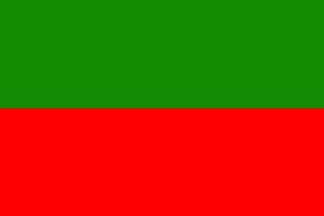 image by Ivan Sache, 01 September 2017
image by Ivan Sache, 01 September 2017
Institución Educativa San Gerardo María Mayela is located in Norcasia (Caldas).
The institute is named for St. Gerard Majella (1726-1755, canonized on 11
December 1904 by Pope Pius X), member of the Congregation of the Most Holy
Redeemer (Redemptorists).
Source:: Biography,
The Catholic Encyclopedia
The flag of I.E. San Gerardo Maria Mayela is horizontally divided green-red.
Source: Institute's website
Ivan Sache, 01 September 2017
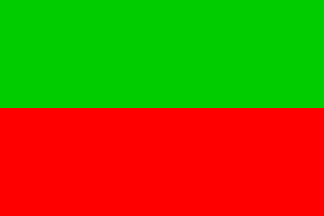 image by Ivan Sache, 19 July 2014
image by Ivan Sache, 19 July 2014
Institución Educativa San Isidro was established in El Espinal (Tolima
Department) by the Institute of the Brothers of the Christian School (Lasallians).
The Lasallians settled in El Espinal on 7 January 1918; Escuela Superior de
Artes was inaugurated on 4 February 1918. The institute was transformed in 1924
into Colegio San Isidro, named for St. Isidore of Seville (560/570-636).
The flag of the institute is horizontally divided green-red.
http://edufanny.wordpress.com/ -
Institute's blog
image by Ivan Sache, 19 July 2014